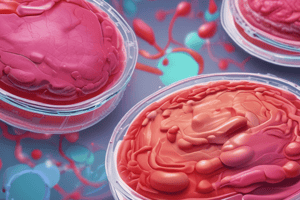Podcast
Questions and Answers
Quale tecnica è utilizzata in anatomia patologica per esaminare campioni di tessuto a livello microscopico?
Quale tecnica è utilizzata in anatomia patologica per esaminare campioni di tessuto a livello microscopico?
- Immunohistochemistry
- Histopathology (correct)
- Microbiologia
- Gross examination
Che tipo di patologia studia le modificazioni molecolari delle malattie?
Che tipo di patologia studia le modificazioni molecolari delle malattie?
- Molecular Pathology (correct)
- Cytopathology
- Clinical Pathology
- Anatomical Pathology
Quale sottospecialità della patologia anatomica studia le malattie del sistema nervoso?
Quale sottospecialità della patologia anatomica studia le malattie del sistema nervoso?
- Cytopathology
- Hematology
- Neuropathology (correct)
- Pediatric pathology
Quale tecnica della patologia molecolare amplifica sequenze di DNA specifiche?
Quale tecnica della patologia molecolare amplifica sequenze di DNA specifiche?
Quale tipo di patologia studia l'analisi di fluidi corporei come sangue e urina?
Quale tipo di patologia studia l'analisi di fluidi corporei come sangue e urina?
Quale tecnica della patologia clinica esamina l'urina per anomalie?
Quale tecnica della patologia clinica esamina l'urina per anomalie?
Study Notes
Pathology
Anatomical Pathology
- Study of the structural and morphological changes in tissues and organs
- Involves the examination of biopsies and surgical specimens to diagnose diseases
- Techniques used:
- Gross examination: visual examination of organs and tissues
- Histopathology: microscopic examination of tissue samples
- Immunohistochemistry: uses antibodies to detect specific proteins in tissues
- Subspecialties:
- Cytopathology: study of individual cells and small clusters of cells
- Neuropathology: study of diseases of the nervous system
- Pediatric pathology: study of diseases in children
Molecular Pathology
- Study of the molecular mechanisms of disease
- Focuses on the analysis of DNA, RNA, and proteins to diagnose and understand diseases
- Techniques used:
- PCR (Polymerase Chain Reaction): amplifies specific DNA sequences
- DNA sequencing: determines the order of nucleotides in DNA
- Microarrays: analyzes gene expression
- Next-generation sequencing (NGS): high-throughput DNA sequencing
- Applications:
- Genetic testing for inherited diseases
- Cancer diagnosis and monitoring
- Infectious disease diagnosis
Clinical Pathology
- Study of the laboratory analysis of bodily fluids, such as blood and urine
- Focuses on the diagnosis and monitoring of diseases through laboratory testing
- Subspecialties:
- Clinical chemistry: study of chemical components of blood and other bodily fluids
- Hematology: study of blood cells and blood clotting
- Microbiology: study of microorganisms and their role in disease
- Immunology: study of the immune system and its disorders
- Techniques used:
- Blood tests: measures various components of blood, such as glucose and cholesterol
- Urinalysis: examination of urine for abnormalities
- Coagulation studies: measures blood clotting function
Studying That Suits You
Use AI to generate personalized quizzes and flashcards to suit your learning preferences.
Description
Questo quiz copre i concetti chiave della patologia, compresi la patologia anatomica, molecolare e clinica. Verifica le tue conoscenze sulla struttura e funzione dei tessuti, sulle tecniche di laboratorio e sulle applicazioni in campo medico.





